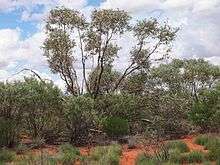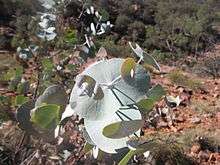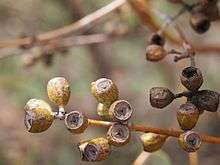Eucalyptus gamophylla
| Warilu | |
|---|---|
 | |
| Eucalyptus gamophylla habit | |
| Scientific classification | |
| Kingdom: | Plantae |
| Clade: | Angiosperms |
| Clade: | Eudicots |
| Clade: | Rosids |
| Order: | Myrtales |
| Family: | Myrtaceae |
| Genus: | Eucalyptus |
| Species: | E. gamophylla |
| Binomial name | |
| Eucalyptus gamophylla | |


Eucalyptus gamophylla, commonly known as warilu,[1] blue-leaved mallee, blue desert mallee[2] or the twin-leaved mallee,[3] is a mallee that is native to Western Australia, South Australia and the Northern Territory.[4]
Description
The evergreen multi-stemmed mallee typically grows to a height of 1.5 to 7 metres (5 to 23 ft)[4] and forms a lignotuber.[5] Occasionally it has an almost prostate habit.[6] It has rough, hard, stringy-fibrous, yellow-brown to grey bark on the trunk and smooth, yellow-tan to cream bark above.[3] The bark is shed in shreds in short ribbons.[7] Adult leaves are dull and greyish in colour they are sessile and 10 centimetres (3.9 in) in length and 2 cm (0.8 in) wide with an ovate to lanceolate shape.[3] The leaves have an opposite to sub-opposite arrangement.[6]
It blooms from October to December or January to March and produces flowers that are white[4] or cream in colour. Flowers are terminal or axillary in clusters or few-branched panicles in groups of three. Buds are cylinder-shaped to pear-shaped 7 mm (0.28 in) in length and 45 mm (1.8 in) wide, on very short stalk. Smooth pruinose fruit will form later that are narrowly cone to cylinder-shaped about to 16 mm (0.63 in) long and 7 mm (0.28 in) wide.[3]
Taxonomy
The species was first formally described by the botanist Ferdinand von Mueller in 1878 as part of the work Fragmenta Phytographiae Australiae.[8] The type specimen was collected by John Forrest from Mount Pyrten in the Hamersley Range and cited as In monte Pyrten tractus Hammersley-Range, altitudine 2,500' supra mare.[9]
Range
It is found on sandplains and sand dunes and in stony spinifex country. It has a range extending from the Mid West, Pilbara and Goldfields-Esperance regions of central Western Australia.[4] extending east into central and southern areas of the Northern Territory[10] and the far north of South Australia.[11] Species commonly associated with E. gamophylla include Triodia basedowii, Acacia ligulata, Acacia georginae, Eremophila longifolia and Eragrostis eriopoda.[12]
Cultivation
E. gamophylla is drought tolerant and hardy in the cold able to tolerate temperatures as low as 10 to 15 °F (−12 to −9 °C)[7] and frost tolerant. When cultivated for the garden it is bird attracting,[10] fast growing, requires very little maintenance and can provide plenty of aromatic cut foliage for flower arrangements.[7]
See also
References
- ↑ Dean Nicolle. "Native Eucalypts of South Australia". Retrieved 15 October 2016.
- ↑ "Eucalyptus gamophylla Blue Desert Mallee". Nindethana seeds. Retrieved 16 October 2016.
- 1 2 3 4 "Eucalyptus gamophylla (Myrtaceae) Twin-leaved Mallee". Seeds of South Australia. Botanic Gardens of South Australia. Retrieved 16 October 2016.
- 1 2 3 4 "Eucalyptus gamophylla". FloraBase. Western Australian Government Department of Parks and Wildlife.
- ↑ "Eucalyptus gamophylla Warilu, Blue-leaved mallee". Windmill Outback Nursery. 2003. Retrieved 16 October 2016.
- 1 2 Todd Erickson; Russell Barrett; David Merritt; Kingsley Dixon (2016). Pilbara Seed Atlas and Field Guide: Plant Restoration in Australia's Arid Northwest. CSIRO publishing. ISBN 9781486305544.
- 1 2 3 "Eucalyptus gamophylla". plantlust. Retrieved 16 October 2016.
- ↑ "Eucalyptus gamophylla F.Muell". Atlas of Living Australia. Global Biodiversity Information Facility. Retrieved 4 December 2017.
- ↑ "Eucalyptus gamophylla". Eucalink. Royal Botanic Garden, Sydney. Retrieved 4 December 2017.
- 1 2 "Eucalyptus gamophylla". Alice Springs Town Council. Retrieved 16 October 2016.
- ↑ "Eucalyptus gamophylla F.Muell". Atlas of Living Australia. Global Biodiversity Information Facility. Retrieved 16 October 2016.
- ↑ David A. Keith (2017). Australian Vegetation. Cambridge University Press. ISBN 9781107118430.